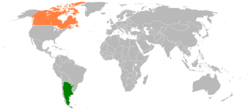Argentina–Canada relations
 |
|
Argentina |
Canada |
|---|---|
Argentina–Canada relations are foreign relations between the Argentine Republic and Canada, began as an assignment in 1945. Argentina has an embassy in Ottawa and 2 consul-general (in Montreal and Toronto). Canada has an embassy in Buenos Aires. Both countries are members of the Organization of American States and the Cairns Group.
Canada and Argentina cooperate closely on many regional and global issues. They share a similar approach to reforming the United Nations in order to make it more effective and a better representation of today's world, and cooperate on current global issues related to the environment, pandemics, counter-terrorism and cultural diversity. Peacekeeping troops from both countries regularly participate in training courses held at the other country’s training centre. At the hemispheric level, the two countries are jointly engaged in reconstruction and peacekeeping operations in Haiti, and were active participants in the Group of Friends negotiations that led to the renewal of the MINUSTAH's mandate by the UN Security Council.
As of 2012, there are 19,210 Argentines residing in Canada.
Trade
Argentina’s GDP has grown by around 9% per year for the last three years. Many Canadian companies have been associated with this growth. They have been able to do so partly as a result of the increased recognition that Canadian firms offer distinct capabilities in sectors such as energy, mining, communications, environment and agricultural technology. They have enjoyed success in Argentina where the geography, natural resources, population density and climate conditions are similar to those in Canada.
Helped by the economic recovery, Canadian merchandise exports have more than quadrupled in the last three years to reach over $175 million. Further, bilateral trade in goods hit the $625 million mark in 2005, with Argentine exports accounting for the majority of the trade at $452.5 million.
Canadian direct investment in Argentina has grown to over $4.6 billion, covering a wide array of sectors. Canadian companies have invested in the agro-industrial sector where they produce a variety of products such as fertilizers, processed foods, dairy products, livestock, and fish products. Canada is also active in sectors such as mining, energy, printing, telecommunications and building products.
Atomic Energy of Canada Limited supplied the Embalse Nuclear Power Station in the 1970s and is currently on the bid for Atucha III [1]
Indigenous relations
Over the past decade, relations between the indigenous communities and associations in Canada and Argentina have grown remarkably. Initiatives spanning the political, commercial, international cooperation, academic, cultural and Information Technology (IT) areas have occurred with increasing frequency. Indigenous leaders of Argentina have received many official delegations from Canada to exchange views and experiences. In October/November 2005, the II Indigenous Summit of the Americas was held in Buenos Aires and Mendoza, with the assistance of the government of Canada and organizational support from the Assembly of First Nations in Canada.
The arts have also strengthened the relationship between Argentine and Canadian indigenous peoples, mainly since the Masters of the Arctic exhibit came to Argentina. In Buenos Aires, there is a totem pole on display in Canada Square, which was built and donated by the Kwakiutl nation. At the University of Rosario there is an Inukshuk built in their Canada Square by artist David Piktoukoun. The Canadian Studies Association of Argentina sustains an Indigenous Chair run by indigenous members and has supported projects in a wide variety of fields (indigenous health, education, arts, social policies and organization, new technologies) and supports congresses and seminars where issues of cultural diversity, human rights and environmental awareness take center stage.
See also
- Argentine Canadian
- Foreign relations of Argentina
- Foreign relations of Canada
- Embassy of Argentina in Ottawa
References
External links
- Argentina embassy in Ottawa
- List of Treaties ruling relations Argentina and Canada (Argentine Foreign Ministry, in Spanish)
- Canada-Argentina Relations
- Canadian Foreign Affairs and International Trade Office about relations with Argentina
- Canadian embassy in Buenos Aires

